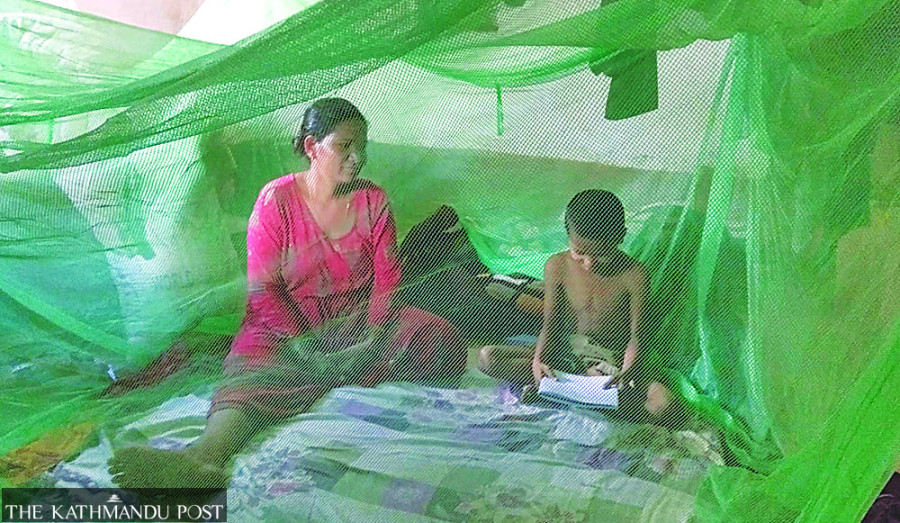Health
Budget cuts for mosquito nets and testing kits stymie Nepal’s fight against malaria
Plasmodium falciparum, a protozoan parasite that most often causes severe and life-threatening malaria, is being found more commonly, officials say. Twenty-three cases of malaria have been reported in various districts since the start of 2023.
Arjun Poudel
The plan was to procure 180,000 lasting insecticide-treated bed nets for the ongoing fiscal year but only 120,000 nets were purchased. The Epidemiology and Disease Control Division had planned to buy 500,000 malaria testing rapid diagnostic kits for the ongoing fiscal year but it purchased only 315,000 pieces.
Distribution of insecticidal nets in the affected areas, and testing of the suspected cases are among the measures considered instrumental to preventing an outbreak of the deadly disease, officials say.
“Budget crunch is the main reason why we could not purchase the most needed materials in the fight against malaria,” said an official at the Ministry of Health and Population. “We are not able to run several other programmes of malaria control in a full-fledged manner due to the budget deficit.”
Malaria is caused by Plasmodium parasites. Infected female Anopheles mosquitoes carry these deadly parasites, according to the World Health Organisation.
Officials at the health ministry said that until now Plasmodium Vivax, a protozoan parasite, was responsible for most of the malaria cases in the country, which causes relatively less severe disease. However, cases of Plasmodium falciparum, which most often causes severe and life-threatening malaria, have been rising. The parasite is very common in many countries in Africa south of the Sahara desert.
“The threat of malaria infection has extended from the Tarai to the hills and mountain regions,” said Dr Gokarna Dahal, chief of the Vector Control Section at the division. “Several new challenges have also emerged in our fight against Malaria and it’s a fact that we do not have sufficient budget to deal with the challenges.”
Nepal is among the UN health body’s E-2025 member countries that have the potential to eliminate the disease by 2025. In April 2021, the UN health agency launched the E-2025 initiative to halt the transmission of malaria in 25 identified countries by 2025. The government has also committed to meeting the deadline.
To earn the ‘malaria-free’ status in 2026, Nepal needs to bring down indigenous cases or local transmission of the disease to zero and zero deaths from 2023, and sustain zero cases for three consecutive years, according to the World Health Organisation.
Officials say the failure to carry out sufficient testing and to distribute lasting insecticide-treated bed nets could hinder the government in its malaria elimination goal.
The health ministry purchases such nets for distribution among the residents of the areas where malaria cases are detected. Two persons of each household get an insecticide-treated bed net and when a woman of a particular house becomes pregnant she gets a net too. Single women and women whose husbands are away for employment get separate nets.
Ministry officials said that despite investments from the government and the Global Fund in the malaria elimination programme, the allocated funds are insufficient.
“Imported cases of malaria have been rising, and the problems caused by open and porous borders have not been controlled,” said Dahal. “Infections have been reported even from the districts considered non-endemic in the past.”
According to data provided by the division, 517 cases of malaria were detected in the country in 2022. Officials say most of the malaria cases come from India. Some people returning from the Middle East and Africa (especially security personnel serving in UN missions) are also found to be infected with the disease.
Malaria has been reported even in the mountainous districts such as Mugu, Bajura and Humla that were considered non-endemic in the past. In 2022, 1,566 cases of malaria were diagnosed in Sudurpaschim Province, 157 in Lumbini, 42 in Karnali, 69 in Madhesh, 49 in Bagmati, 19 in Gandaki and 15 in Province 1. Infections have been reported from 51 of the 77 districts across the country.
The health ministry shows at least 21 new cases of malaria reported from various districts throughout the country since the start of 2023.




 8.12°C Kathmandu
8.12°C Kathmandu













%20(1).jpg&w=300&height=200)
